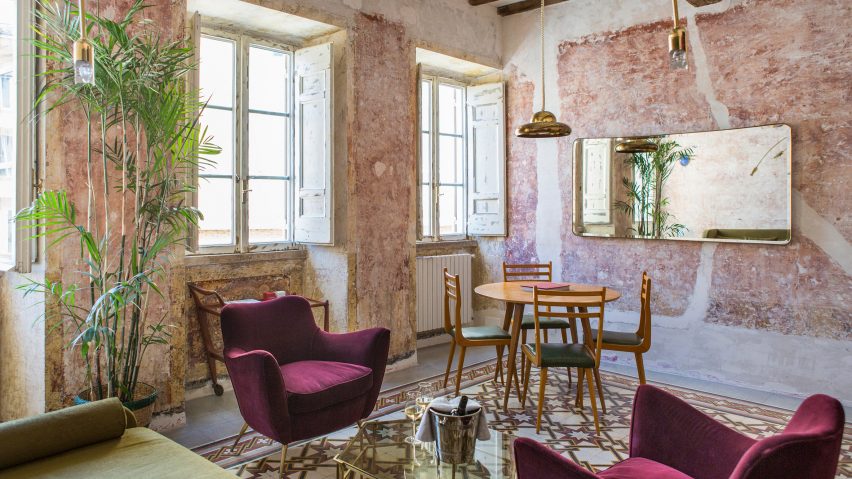Mirrored tiles, patina walls, contemporary art and modernist Italian furniture make up this hotel within a 17th-century palazzo in Rome, which was formerly the family home of the owner.
Gabriele Salini has transformed the historic property, which was his family's home for hundreds of years, into a boutique hotel called G-Rough.
He designed the five-storey hotel in the heart of Rome to reflect his passion for art, history and modernist design.
Salini collaborated with Giorgia Cerulli, Benedetta Salini, Vittorio Mango and Emanuele Garosci to create G-Rough hotel with a rough-yet-refined aesthetic carried throughout.
The building was originally built in the 1600s, and the conversion has been designed to showcase its 400-year-old history. Original timber ceilings have been preserved and left exposed, while walls layered with hundreds of years of paint are visible in many rooms.
These historic touches are offset with contemporary art and mid-century furnishings.
Modern details include an infinity mirror with red lights and industrial cabinets that serve as kitchenettes. The hotel suite bathrooms, lobby and public breakfast are covered in mirrored tiles in silver and gold.
G-Rough comprises ten hotel suites that are each individually decorated, but are laid out in similar fashion with common furnishings. All of them aim to fuse 1600s elegance and Italian modernism.
Several hotel rooms have a space for entertaining with a dining table, chairs and an oversized sofa that can serve as a spare bed. A coffee table, kitchenette, lamps and Smeg refrigerators round out the space.
Each of the suites has a private bedroom and a bathroom. Clawfoot bathtubs, floor-to-ceiling windows that peer out into the suite's hall, and two-tone cast-iron washbasins nod to the historic site with a playful touch.
The rooms furnishing are complete with a variety of reclaimed modernist and vintage pieces from Sicilian design brand Leftover.
On the top floor of G-Rough are two penthouse suites that can be joined together.
The penthouses open out onto rooftop terraces that overlook the cobblestone streets and palazzo buildings of Rome's Piazza Navona Square.
Much of the furniture used throughout the hotel inspired by modernist Italian designers from the 1930s and 1950s, such as Ico Parisi, Giò Ponti, Paolo Venini, Seguso and Piero Fornasetti.
Pieces include spider-limbed Sputnik chandeliers, parchment beds and bar trolleys.
A handful of other boutique hotels have opened in the Italian city in recent years, including Condomonio Monti and Rooms of Rome by Jean Nouvel, which is also a renovated palazzo with weathered walls and contemporary furniture.
Photography is by Serena Eller.

